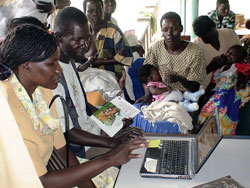Malaria prevention goes online
January - February, 2009 | Volume 8, Issue 1

Photo by Julia Royall
Residents of the village of Mifune, Uganda learn by
computer and color pamphlet about how to prevent
and recognize malaria. The National Library of
Medicine's Julia Royall helped create multimedia
informational presentations.A National Library of Medicine project has created an online tutorial to help Ugandans easily understand the cause, scope and prevention of malaria.
Returning from a Fulbright fellowship in the country, NLM’s malaria research network chief, Julia Royall, explained her project at a public lecture.
Malaria kills between 70,000 and 110,000 Ugandans each year, she said, and much of the problem is due to myths and folklore about mangoes, corn or witchraft causing the disease.
Her implementation project, in conjunction with Makerere University, created an interactive tutorial on malaria in English, Luanda, Rukiga and Luo based on the work of students, faculty and Ugandan artists.
Villagers reviewed the MedlinePlus Tutorials for Africa. Computer discs were sent to the country’s 20 districts.
To view Adobe PDF files,
download current, free accessible plug-ins from Adobe's website.